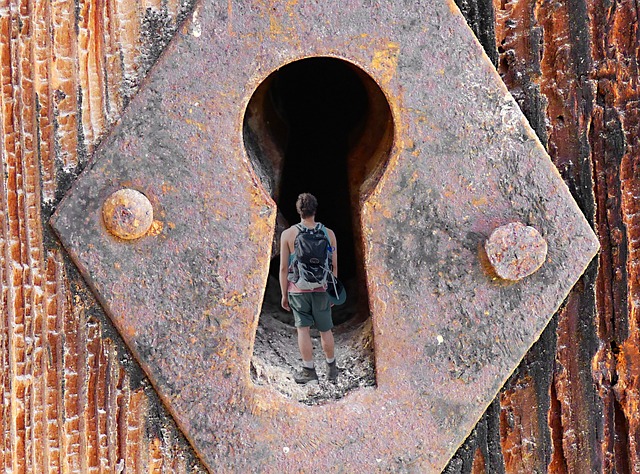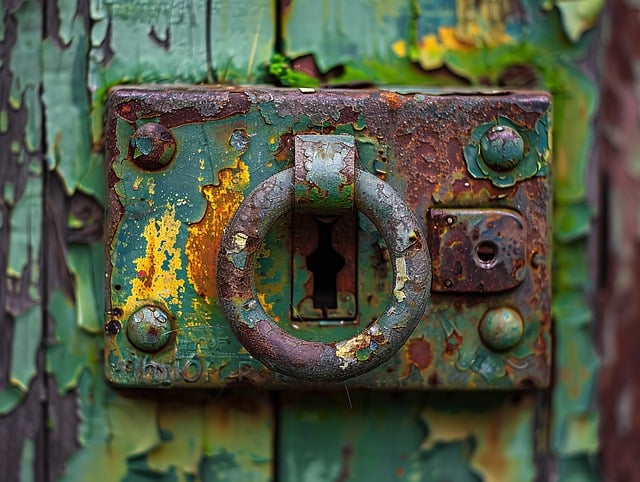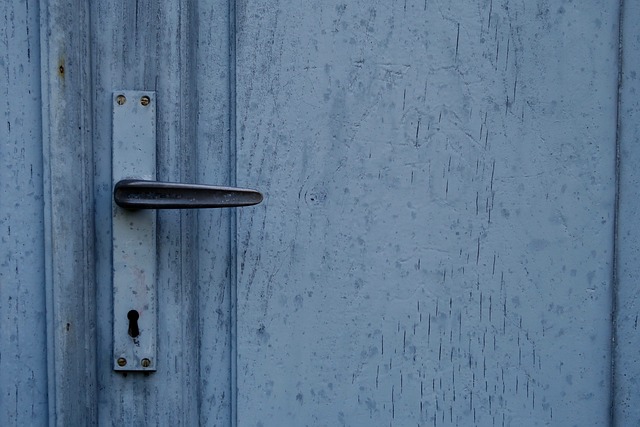Modern home security has been transformed by keyless entry and digital locks, offering a secure and convenient alternative to traditional keys. These systems enable remote management of access through smart devices, integrating with broader home automation platforms to provide real-time alerts, entry history tracking, and advanced encryption options. They eliminate the need for physical keys and facilitate unique access codes for various users, which can be easily created and revoked as needed. The transition to smart access control systems represents a significant advancement in home entry security, catering to the modern consumer's need for both convenience and safety. Digital locks are sophisticated, reliable, efficient, and state-of-the-art, providing keyless entry through various methods like keypad codes or mobile app integration. Proper installation is critical and involves following the manufacturer's instructions, preparing the strike plate, and connecting with home automation systems if applicable. Regular software updates are necessary to maintain security features and reliability. The integration of these systems within home automation not only enhances security but also personalizes the living experience by allowing smart homes to respond to authorized individuals with adjustments like lighting or temperature settings. As technology advances, AI and ML have the potential to make these systems even more intuitive and secure in the future. For those experiencing issues with their access control devices, troubleshooting is essential to ensure smooth operation, and regular maintenance checks are advised to prevent malfunctions due to wear and tear or environmental factors. In summary, keyless entry systems and digital locks have revolutionized home security by providing convenient, secure, and personalized access solutions within the realm of home automation.
Secure and efficient access control has become a cornerstone of modern home entry systems, offering a keyless, digital alternative to traditional locks. This article delves into the seamless installation and management of access control devices, exploring the integration of these systems with home automation for an enhanced security experience. From understanding the intricacies of keyless entry and digital locks to troubleshooting common issues, we provide comprehensive guidance for homeowners to effectively manage users and permissions. Prepare to elevate your home’s security access while effortlessly integrating controlled entry into your daily life.
- Understanding Access Control Systems: The Role of Keyless Entry and Digital Locks in Home Entry Security
- Installing Your First Digital Lock: A Step-by-Step Guide for Homeowners
- Integrating Access Control with Home Automation: Enhancing Controlled Entry Experience
- Managing Users and Permissions: Best Practices for Efficient Access Control Management
- Troubleshooting Common Issues in Keyless Entry Systems and Digital Locks
Understanding Access Control Systems: The Role of Keyless Entry and Digital Locks in Home Entry Security

In contemporary home security, access control systems have become synonymous with advanced keyless entry and digital locks, offering a formidable barrier against unauthorized access. These sophisticated systems replace traditional keys with secure electronic credentials, allowing for precise controlled entry into residential spaces. Homeowners can enjoy the convenience of remotely managing who has access to their home through these smart systems, which often integrate with broader home automation platforms. The benefits of keyless entry are manifold; it not only eliminates the need to carry physical keys but also provides a higher level of security due to the ability to issue temporary digital codes, track entry history, and receive real-time alerts. Digital locks enhance this security by combining robust encryption with biometric identification options, ensuring that home entry is both user-friendly and secure, thus safeguarding one’s sanctuary with cutting-edge technology.
The transition from mechanical locks to smart access control systems has been a game-changer in home entry security. These systems offer homeowners the ability to create unique access codes for family members, guests, or service providers, granting them entry only when needed and revoking access just as easily. The integration of digital locks into home automation ecosystems allows for seamless management through smartphones or other connected devices. This level of control over home entry is not only a testament to the advancements in security technology but also a reflection of the modern consumer’s desire for convenience without compromising on safety. With keyless entry and digital locks, homeowners can rest assured that their dwellings are protected by reliable, efficient, and sophisticated access control systems.
Installing Your First Digital Lock: A Step-by-Step Guide for Homeowners

When integrating a digital lock into your home for secure and convenient home entry, it’s crucial to approach the installation with precision and attention to detail. The first step involves carefully reading the manufacturer’s instructions specific to the model of digital lock you have purchased. This ensures that you follow the correct access control procedures tailored to your device. Access control systems are designed to simplify home automation, allowing for keyless entry through various means such as keypad codes, biometric identification, or mobile app integration. Once installed, these systems provide a reliable security access point, eliminating the need for traditional keys and enhancing controlled entry to your residence.
For the actual installation process, begin by removing the existing lock or latch, which may require a screwdriver or lock removal tools depending on the model. Next, prepare the strike plate where the digital lock will engage—this often involves cleaning off any old adhesive and ensuring a smooth surface for optimal security access functionality. After affixing the new digital lock to the door, align the interior and exterior components, and proceed to connect it to your home automation system if applicable. Finally, configure the lock’s settings through its interface or associated mobile app to personalize user access and ensure seamless management of who can enter your home. Regularly update the software to maintain its security features and reliability, thus safeguarding your property with a state-of-the-art digital lock system.
Integrating Access Control with Home Automation: Enhancing Controlled Entry Experience

In the realm of home automation, integrating access control solutions like Keyless Entry systems has become a cornerstone for enhancing the controlled entry experience. These Digital Locks offer a seamless blend of convenience and security, allowing residents to manage who enters their home with a simple touch or code input. The advantage of such systems lies in their adaptability; they can be programmed to recognize multiple access codes or digital keys, and users can modify permissions remotely via smartphones or other connected devices. This not only simplifies the management of who has access to your home but also keeps security access up-to-date without the need for physical key replacements.
The fusion of Home Entry systems with broader home automation setups creates a dynamic and responsive living environment. For instance, digital locks can be integrated with smart home platforms to trigger certain actions; if an authorized individual arrives home, the lights could automatically turn on, or the thermostat could adjust to a more comfortable setting. This integration not only heightens security but also adds layers of personalization to the daily experience of coming and going from your home. As Home Automation continues to evolve, the potential for these systems to learn and adapt to user behaviors presents an exciting frontier in controlled entry technology. With ongoing advancements in artificial intelligence and machine learning, future access control devices promise to offer even more intuitive and secure home entry solutions.
Managing Users and Permissions: Best Practices for Efficient Access Control Management

In the realm of home automation, managing users and permissions through access control systems has become a cornerstone of modern security practices. With the advent of keyless entry technologies, digital locks have rendered traditional keys obsolete, offering a more sophisticated and flexible means of home entry management. To ensure seamless controlled entry, it is paramount to establish clear user roles and permission levels. This approach allows for granular access control, where different users can be granted varying degrees of privilege, from full access to limited or temporary permissions. Utilizing a centralized platform for managing these digital locks empowers homeowners to easily add or remove users, update permissions, and keep track of who has accessed the property and when. This not only enhances security but also simplifies the process of home entry management, allowing for a more streamlined and efficient operation within the confines of home automation systems.
Advancements in security access technologies have necessitated the development of best practices for managing users and permissions in access control systems. A robust system should incorporate multi-factor authentication to verify user identities beyond a shadow of doubt. Regular audits of user privileges and access logs are essential to maintaining a secure environment, as they help identify any potential security breaches or unauthorized attempts to gain entry. Additionally, incorporating a mobile application for real-time management of users and permissions can provide homeowners with the convenience of monitoring and controlling their home entry points from anywhere at any time. By adhering to these best practices, homeowners can effectively manage their access control devices, ensuring that only authorized individuals have access to their premises, thereby safeguarding their homes against unauthorized entries and potential security threats.
Troubleshooting Common Issues in Keyless Entry Systems and Digital Locks

When installing or managing access control devices such as keyless entry systems and digital locks within home entry frameworks, users may encounter various issues that can disrupt security access. Common troubleshooting steps for these problems are essential for maintaining controlled entry in home automation environments. One prevalent issue is the failure to program the system correctly, which can prevent the keyless entry device from recognizing authorized users or codes. To resolve this, it’s advisable to consult the user manual for precise programming instructions or seek professional assistance to ensure accuracy. Another frequent problem arises when the digital lock mechanism becomes jammed or unresponsive due to wear and tear or exposure to extreme temperatures. Regular maintenance checks can help preempt such issues by identifying potential problems before they escalate, thus maintaining the integrity of the security access system. Additionally, ensuring that all digital locks are compatible with the home automation system is crucial for seamless operation. This compatibility ensures that users can remotely manage access without encountering connectivity or software incompatibility challenges. By staying vigilant and proactive in addressing these common issues, users can maintain a high level of security and convenience through their keyless entry systems and digital locks. Home automation advancements have made managing controlled entry more user-friendly, but technical glitches can still occur, emphasizing the importance of understanding basic troubleshooting steps for these devices.
In conclusion, the advent of sophisticated access control devices has revolutionized home entry security, offering a seamless and secure way to manage who enters your home. By understanding the core components of keyless entry systems and digital locks, homeowners can install these modern solutions with confidence, as outlined in our comprehensive step-by-step guide. Integrating these systems with home automation not only enhances the controlled entry experience but also provides a unified platform for managing all aspects of your home environment. Managing users and permissions effectively is crucial for maintaining security access integrity. Homeowners should employ best practices to ensure efficient access control management. Should issues arise, our troubleshooting guide offers solutions to common problems, ensuring that your keyless entry system operates smoothly at all times. Embracing these technologies is a prudent step towards fortifying your home’s security and embracing the future of controlled entry systems.
